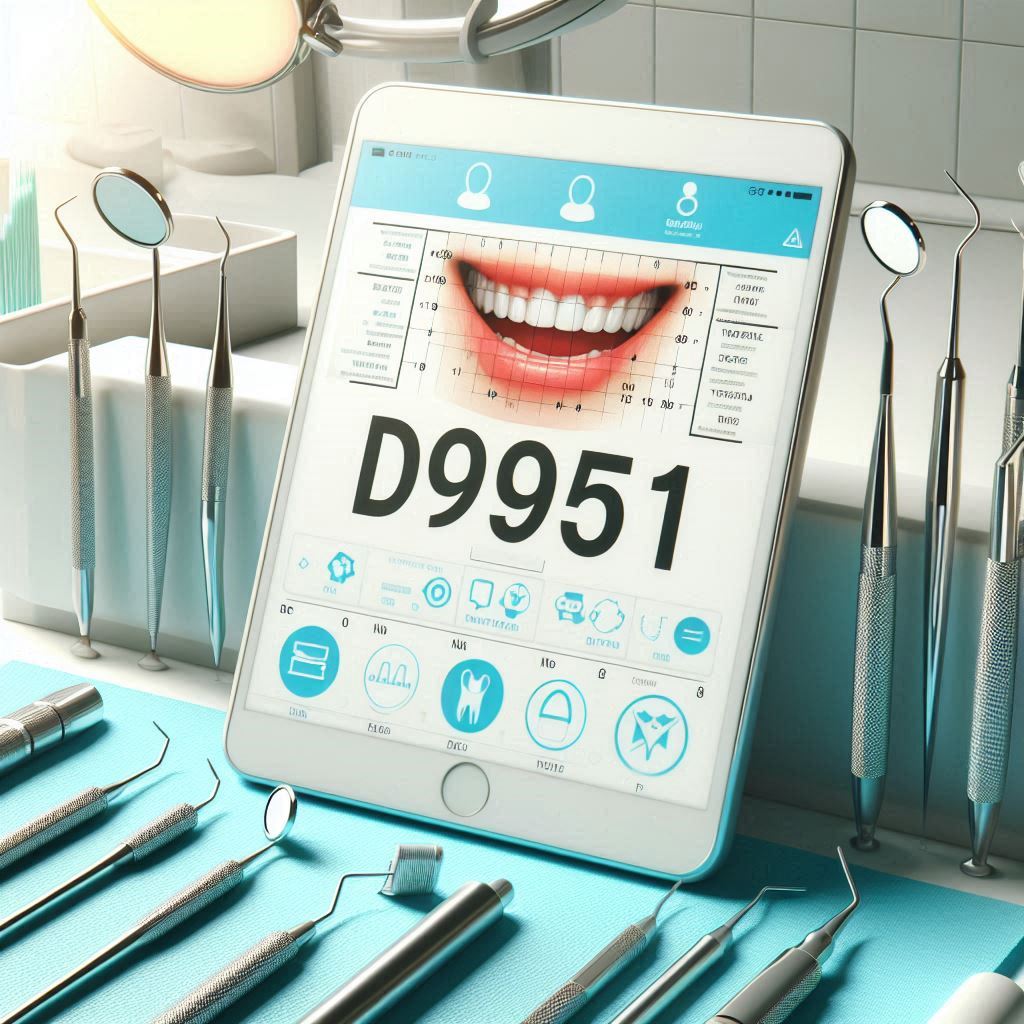D9951 Dental Code
Dental billing codes can be complex, and understanding them is crucial for both practitioners and patients. One such code, D9951, refers to occlusal adjustment—a procedure designed to correct bite imbalances and improve oral function. Misaligned bites can lead to TMJ disorders, tooth wear, and even chronic headaches. This article provides an in-depth exploration of the D9951 dental code, its clinical applications, procedural steps, and financial considerations.
Whether you’re a dental professional seeking clarity on billing or a patient curious about bite correction, this guide offers valuable insights into occlusal adjustment and its role in modern dentistry.

2. What is the D9951 Dental Code?
The D9951 code, as defined by the American Dental Association (ADA), is used for occlusal adjustment by grinding. This procedure involves selectively reshaping tooth surfaces to achieve better bite alignment.
Key Features of D9951:
- Non-invasive (no surgical intervention)
- Focused on functional correction (not cosmetic)
- Often used alongside restorative treatments
When is D9951 Billed?
- After placing crowns, bridges, or fillings
- For patients with bruxism (teeth grinding)
- In cases of TMJ dysfunction
3. Understanding Occlusal Adjustment
Occlusal adjustment is a precision-based procedure aimed at eliminating premature contacts and balancing bite forces. An improper bite can cause:
- Tooth fractures
- Muscle pain (TMD/TMJ disorders)
- Gum recession
- Chronic headaches
Types of Occlusal Adjustments
| Type | Description |
|---|---|
| Selective Grinding | Reshapes specific teeth to improve bite |
| Equilibration | Full-mouth adjustment for severe misalignment |
| Orthodontic Correction | Uses braces/aligners for long-term bite correction |
4. When is D9951 Necessary?
Common Scenarios for Occlusal Adjustment:
✔ After Dental Restorations – Crowns or fillings may alter bite alignment.
✔ Bruxism (Teeth Grinding) – Prevents excessive wear.
✔ TMJ Pain – Reduces strain on jaw joints.
✔ Orthodontic Relapse – Corrects shifting after braces.
Diagnostic Tools Used:
- Articulating Paper (marks high spots)
- T-Scan Digital Bite Analysis (electronic bite mapping)
- CBCT Scans (3D imaging for severe cases)
5. The Procedure: Step-by-Step Guide
- Initial Examination – Dentist evaluates bite using articulating paper.
- Marking Problem Areas – High spots are identified.
- Precision Grinding – Minimal enamel removal for balance.
- Polishing – Smoothens adjusted surfaces.
- Follow-Up – Ensures bite stability.
6. Benefits of Occlusal Adjustment
✅ Reduces Jaw Pain – Alleviates TMJ discomfort.
✅ Prevents Tooth Damage – Minimizes cracks and fractures.
✅ Improves Chewing Efficiency – Enhances digestion.
✅ Long-Term Oral Health – Lowers risk of gum disease.
7. Potential Risks and Complications
While generally safe, improper adjustments can lead to:
- Overgrinding (weakened teeth)
- Temporary sensitivity
- Need for further corrections
Best Practice: Always seek an experienced dentist.
8. D9951 vs. Other Bite Adjustment Codes
| Code | Description |
|---|---|
| D9951 | Occlusal adjustment by grinding |
| D9944 | Occlusal guard (for bruxism) |
| D9110 | Palliative treatment (emergency pain relief) |
9. Insurance and Reimbursement for D9951
- Coverage varies – Some insurers classify it as medically necessary.
- Pre-authorization may be required.
- Out-of-pocket cost: 100−100−400 per arch.
10. FAQs on D9951 and Occlusal Adjustment
Q1: Does occlusal adjustment hurt?
No, it’s painless—only minor enamel is removed.
Q2: How long does the procedure take?
Typically 15-30 minutes per arch.
Q3: Will my bite feel different afterward?
Yes, but most patients adapt within days.
Q4: Can occlusal adjustment fix TMJ?
It can help, but severe cases may require splints or surgery.
11. Conclusion
The D9951 dental code plays a vital role in bite correction, offering relief from TMJ pain, tooth wear, and improper chewing. By understanding its applications, benefits, and limitations, both dentists and patients can make informed decisions. If you experience bite-related discomfort, consult a dental professional to explore occlusal adjustment as a solution.
12. Additional Resources
- American Dental Association (ADA) Code Manual
- Journal of Prosthetic Dentistry – Occlusal Studies
- TMJ Association – Bite Correction Guide


